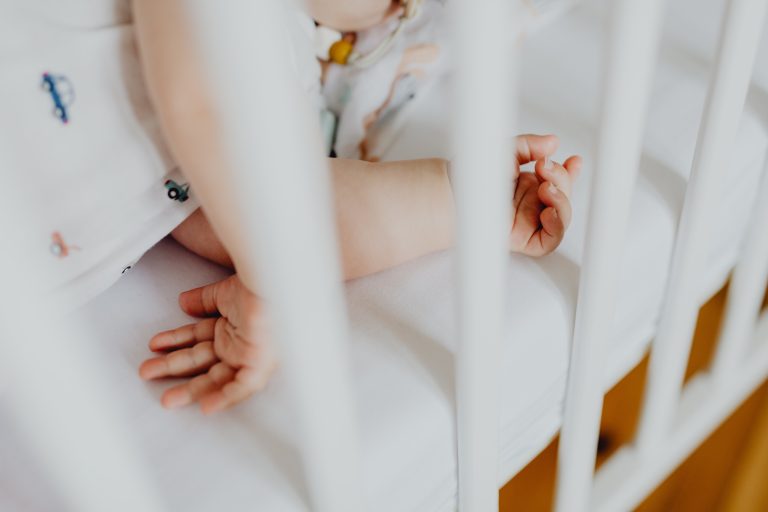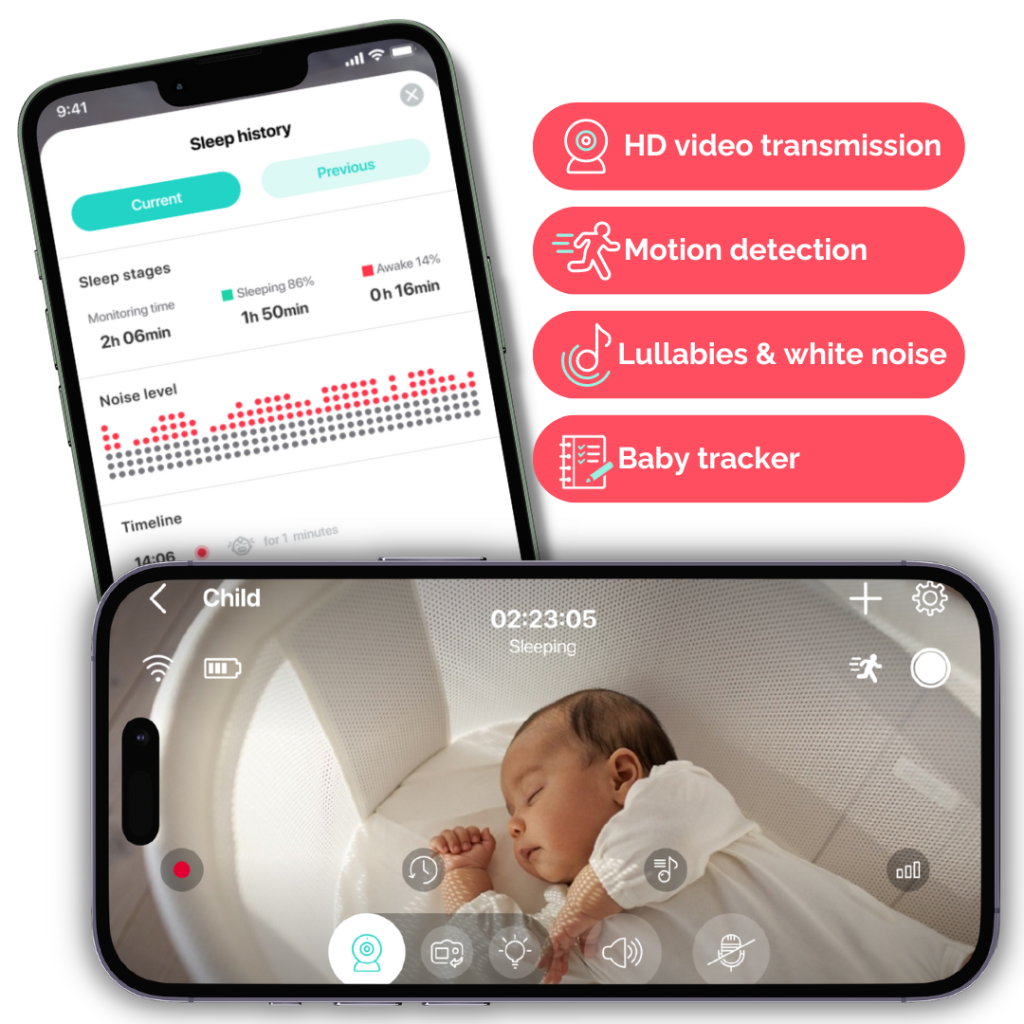
Wake Windows by Age: Optimizing Your Baby’s Sleep Schedule
- Created:
20. 7. 2023 - Updated:
15. 2. 2024
Fact:
Babies can spend almost the whole day sleeping, which forever remains a wonder.
But while we let them enjoy this productive inactivity, one question roams parents’ minds rent-free:
How much sleep is enough?
Good news:
You can monitor your baby’s sleep and plan their routines using wake windows, which are affected by many factors, including age.
As such:
This article helps you understand wake windows by age and how to use them to optimize your infant’s sleep.
Let’s begin.
Navigating Baby Wake Window by Age: A Roadmap to Restful Naps and Nights
Wake windows vary depending on your child’s age. Generally, as babies grow up, they become more active and, thus, have wider wake windows. Here’s a chart to help you identify how long your child spends awake:
| Age | Wake window |
| 0-3 months | 45 minutes-1 hour |
| 4-11 months | 2-3 hours |
| 1-2 years | 3-4 hours |
Wake Window for Newborns (0-3 months)
Get this:
A wake window is the time a baby spends awake between naps.
Theoretically:
The younger a child is, the shorter their wake window. To this effect, newborns (children between 0-3 months) typically have a relatively short wake window of about 45 minutes to 1 hour.
As a parent of a newborn, you must have noticed that babies spend a huge portion of their day asleep: it’s nothing compared to the time they spend awake.
Fact:
KidsHealth says some newborns sleep up to 18-19 hours daily. This leaves only around 5-6 hours for them to spend awake.
Ideally:
Newborns spend a lot of time asleep because they are taking in a lot of information and have no sense of day and night. Hence, their sleep schedule heavily depends on whether or not they’re tired and how comfortable they are.
Of course:
Babies don’t sleep for 18 hours at a stretch.
Instead:
They need to sleep for short periodic intervals at a time. And generally, they spend about 2-4 hours sleeping, only waking up to eat or if uncomfortable.
So:
For them to get the best naps, where the newborn should sleep should be a safe and comfortable environment.
Wake Window for Infants (4-11 months)
Get this:
Babies don’t get a regular sleep schedule till about six months of age, according to healthychildren.org
They spend less time asleep around this period and can go relatively long without eating. Hence, they wouldn’t wake up as much in the middle of the night.
Now:
Infants around this age limit have a more stable sleep routine because they are more aware of day and night. Thus, they adapt to the time difference between these ages.
As we’ve mentioned earlier:
Babies’ wake windows increase as they grow, and their sleep patterns become more predictive. Consequently, infants around 4-11 months of age can stay awake for 2-3 hours between naps.
Additionally:
Babies within these ages need about 11 hours of sleep at night. They also have 2-3 naps daily, which add up to 3-4 napping hours.
In support:
The American Academy of Sleep Medicine (AASM) recommends that infants within this age group should sleep for 12-16 hours daily. Ultimately, it promotes good infant health.
Remember:
Around this age, you might have to move your baby from the bassinet to the crib. The baby tends to grow noticeably larger within this period, and they might outgrow the bassinet.
Wake Windows for Toddlers (1-2 years)
Check this out:
According to a recent study, around 2.5% of toddlers below the age of 2 stop napping entirely. From this, we can gather that the older a child gets, the less time they spend napping.
As such:
Toddlers typically have longer wake windows that last about 3-4 hours and might only need one nap daily.
This is because they are more adapted to day and nighttime. So it’s easier to develop a comfortable sleep routine for the child.
Generally:
Toddlers between 1-2 years only need about 11 hours of sleep daily, including napping time.
Take note:
Children between 1-2 years are more active, so they might indulge in games or exerting activities rather than sleep.
During this period, you can introduce them to different games for toddlers, such as picture games or nursery rhymes.

Factors that Affect Wake Windows
Question:
Why does my baby stay awake for most of the day? Is it healthy?
Franky:
Various factors can significantly affect how much time your baby spends awake between naps. These factors can either make your baby spend more time awake or less.
Interestingly:
As these factors change, so does your baby’s wake window. Hence, with time, wake windows evolve.
For this reason, it is always advisable to be familiar with your baby’s needs and adapt to the changes as they occur.
In this section, we will discuss the factors that affect your baby’s wake window and how they do so.
Let’s get right into it!
1. The Baby’s Age
Undoubtedly:
A baby’s age is a vital factor affecting their wake window. While age doesn’t directly affect the wake window, it controls some factors that directly affect the wake window.
For instance:
Age affects how the baby’s body systems work. So, the more a baby grows, the more the body carries out various functions like digestion effectively.
In digestion, infants between 0-3 months of age are more prone to constipation than toddlers. Constipation disrupts the baby’s sleep by causing them discomfort and pain.
Consequently:
It increases their wake window.
So:
Since toddlers are less prone to constipation, they have higher chances of sleeping longer, especially at night.
As a result:
The older a baby gets, the longer they stay awake between naps.
2. Baby’s Sleep Position
News:
The position in which your baby falls asleep determines how well they’d sleep.
That’s right!
Basically:
If your baby sleeps in a position that stresses a joint or muscle, it will cause discomfort. Subsequently, the baby would be unable to sleep.
In fact:
The baby could wake up crying because of the discomfort, and you might be unable to tell the problem. Over time, you might continue putting the baby in that uncomfortable position which would hinder their sleep.
To prevent this, you must place your baby in the best sleeping position, which is to lay them on their back, according to The Lullaby Trust.
Doing so would ensure the baby gets enough rest and prevent the risk of getting Sudden Infant Death Syndrome (SIDS).
3. Baby’s Stage of Development
Different developmental stages in infants come with their complexities. And most times, these issues affect the baby’s sleep directly.
For example:
Teething in babies usually comes with ailments like headaches, fevers, and toothaches. All of these cause discomfort to the baby and disrupt their sleep.
Eventually:
It increases the baby’s wake window and decreases sleeping time.
On the other hand:
There are other developmental processes that increase nighttime sleeping time and daytime wake windows. These include; adaptation to day and nighttime sleep patterns.
Adapting to day and nighttime sleep patterns works like a clock that tells the infant when to sleep. This lets the baby get more nighttime rest and stay more active during the day.
In the end:
Their sleep is more organized and there are lower chances of tiredness after waking.
4. The Baby’s Individual Differences
One thing is for sure:
Just as adults are different from each other, every baby has their unique qualities.
Some babies might have a sensitive system or higher metabolism, which could make them more active than other babies.
So:
If your baby stays awake longer than you expect and you’ve confirmed their healthiness and comfort, don’t panic. Your baby might be more active than others, which isn’t an issue.
Regardless:
It’s advisable to know how to put your baby to sleep safely to prevent them from getting excessively tired.
Final Tip: Annie Baby Monitor – Your Baby Sleep Solution Helper
Annie Baby Monitor is your go-to helper when it comes to optimizing your baby’s sleep schedule based on age-appropriate wake windows.
Helpful features like sleep history, baby tracker, and personalized tips help you track your baby’s sleep patterns and tweak the routine to fit the baby’s developmental stage like a glove.
With Annie’s help, you can customize your baby’s wake-up time and make sure they sleep well throughout the night.

Annie Baby Monitor will guide you in creating the perfect sleep routine for your baby’s changing needs so you both can get the best rest.
Conclusion
Let’s rewind:
Age plays a major role in determining your baby’s wake window. It controls other factors like development and adaptation to day and nighttime, which affect their sleep schedule.
Now:
Depending on your baby’s age, they might have a wide or narrow wake window. Below are some of the wake windows for babies of different ages:
- 0-3 month-olds have an average wake window of 45 minutes to 1 hour
- 4-11 month-olds have an average wake window of 2-3 hours
- 1-2 year-olds have an average wake window of 3-4 hours
Primarily:
Baby wake windows are dependent on the factors below:
- The baby’s age
- The baby’s sleep position
- The baby’s stage of development
- The baby’s individual differences
Remember:
Wake windows are very flexible and can change with time as your baby grows. So, you must learn to find a sleep schedule suitable for the baby without disrupting their body’s natural schedule.
Finally,
Head over to the comment section below if you have any questions, concerns, or comments about wake windows and sleep schedules. Also, let me know if you found this article helpful.
FAQ: Wake Windows by Age
For newborns aged 0-3 months, their wake window should be 45 minutes to 1 hour. Babies between the ages of 4 and 11 months should have a wake window between 2 to 3 hours. Lastly, toddlers between 1 and 2 years should have a wake window of 3 to 4 hours.
You can determine the ideal wake window for your baby by comparing your baby’s age with the recommended wake window. Newborns typically have a wake window of 45 minutes to 1 hour. 4-11 month-olds have a wake window of 2-3 hours. Additionally, toddlers have a wake window of 3-4 hours.
You can adjust your baby’s wake window by monitoring their sleep schedule. You should also make sure that your baby doesn’t wake up tired. To do this, observe how long your baby sleeps and ensure that they spend enough time resting.
Also, the wake window must not creep into your baby’s sleeping time. So, if your baby usually naps for an hour but spends 15 extra minutes awake, you add 15 extra minutes to the sleeping time. This balances the time out and ensures the baby gets enough rest.






